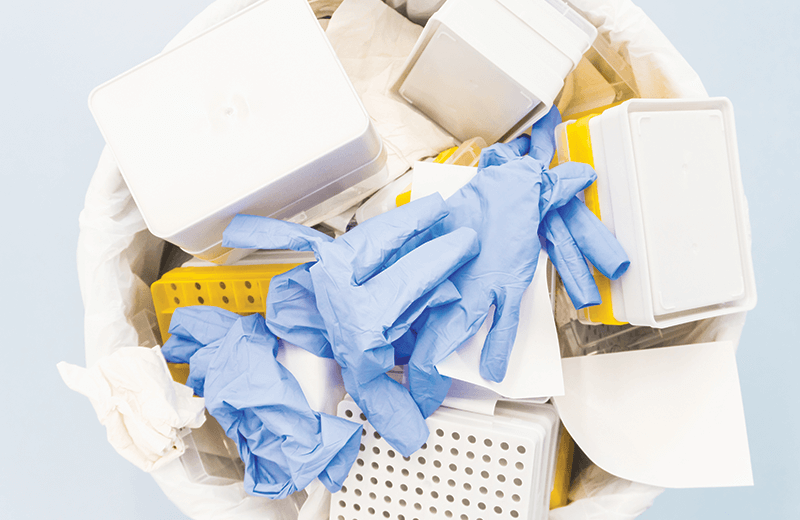For companies that produce medical waste, the ability to safely and reliably package and transport hazardous waste have been top-tier priorities. But as the sustainability movement continues to touch nearly every industry, medical facilities, laboratories, and universities are beginning to evaluate the sustainability of their lab pack processes and solutions in order to adopt a more eco-friendly approach.
Part of the challenge for companies in enhancing the sustainability of their lab packs is the container so many facilities and labs rely on: the 55-gallon steel drum. In fact, the process of reconditioning steel drums for use with hazardous materials like those common in lab packs could change drastically pending EPA legislation aimed at reducing the overall environmental impact of using steel drums.
The good news is there are a couple of strategies companies can consider now to adopt a more sustainable approach to traditional lab packs, and to help optimize the transportation and logistics of this kind of hazardous material.
 Cut your carbon footprint by reducing your number of full truckloads (FTLs)
Cut your carbon footprint by reducing your number of full truckloads (FTLs)
One of the most impactful steps any company can take in service of increasing their sustainability efforts is reducing their individual carbon footprint. For medical facilities or labs that must transport large amounts of hazardous waste, this means reducing the number of full truckloads (FTLs) required to move waste from Point A to Point B – and relying on traditional steel drums as your lab pack solution can stand in the way of this goal.
For example, a standard 53-foot truck has a maximum capacity of just 208 units, which, depending on the quantity of waste, can mean facilitating a large number of FTLs. What’s more, the standard 53-foot truck produces about 22 pounds of CO2 emissions per gallon of diesel fuel and about 3 pounds of CO2 emissions per mile.
Minimizing the number of trucks on the road to reduce your amount of CO2 emissions, and Gorilla Drum’s™ flexible, foldable frame can help labs and medical facilities fit more units on a standard truck to reduce the number of FTLs necessary to meet demand. With Gorilla Drum™, you can fit 80 unfilled units per pallet for a total of 4,160 per standard semi. This represents a 20x increase compared to traditional steel drums, and this increased capacity also means a more cost-effective way of transporting hazardous medical waste.
Prioritize a lab pack solution made from recyclable materials
A surefire way to increase your sustainability efforts is to prioritize using solutions that are recyclable, or those that decrease your environmental impact when they’re deployed in the field. While traditional 55-gallon steel drums can be used more than once to store and transport hazardous medical waste, the reconditioning process requires the burning off of residual waste, or strenuous cleaning procedures that include environmentally harmful solvents.
While the steel used in the production of 55-gallon drums is a recyclable material, drums that cannot adequately be cleaned or conditioned at the end of their service life may not be able to be recycled, thus increasing the likelihood they are landfilled.
Choosing a lab pack solution that is 100% recyclable ensures the container is able to be repurposed at the end of its service life, thus reducing your environmental impact. Gorilla Drum™ uses a recyclable polypropylene frame and fabric inserts that can be responsibly disposed of at the end of a unit’s lifespan.
What’s more, each unit can be reused multiple times without requiring intense washdowns using harsh chemical agents.
What makes Gorilla Drum™ truly unique is that this increased sustainability doesn’t sacrifice protection, durability, and reliability. Gorilla Drum™ is rated for use with the three major packing groups of hazardous material:
- Packing Group I, which consists of materials presenting a high degree of danger
- Packing Group II, which contains materials presenting medium danger
- Packing Group III, which consists of materials presenting low danger
Plus, Gorilla Drum™ is UN and DOT certified, and our corrugated plastic frame design offers a maximum weight capacity of 453 pounds to help you handle whatever waste comes your way.
Want to learn how Gorilla Drum™ helped a global package handler save time and money by conserving warehouse space and streamlining waste hauling processes? Download our new case study to read the full story.


 Cut your carbon footprint by reducing your number of full truckloads (FTLs)
Cut your carbon footprint by reducing your number of full truckloads (FTLs)